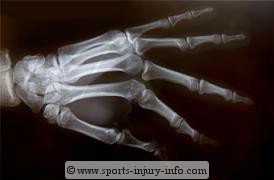Fractures: How Bad Are They?

In all reality, you are probably better off with a broken bone than a ligament sprain. Whats that? You think I must be crazy? Read on to find out all about broken bones, and why they may not be as bad as you thought.
What is a Fracture?
In its simplest terms, a fracture is a broken bone. Bones are hard, stiff tissue that withstand lots of tensile force and load. (here I go again with those big words). Think of your bones as the framework of your body. The soft tissue (muscles, ligaments, tendons, etc) decorate that framework, and allow for movement and cushioning. They also make us look less skeleton like.When a break occurs, the bones are broken in one or many places. They can be small, hairline cracks, complete breaks where the bone breaks all the way through. They can be displaced, meaning the ends of the bones move out of alignment. And the nastiest, compound breaks, when the ends of the bones actually pierce the skin and stick out.
There are over 200 bones in the body, so there are
lots of different possible places in the body this can occur.
How Does It Occur?

Signs and Symptoms
There is usually some type of force that causes the break. It isn't an injury that just creeps up on you. You get hit with a baseball, you roll over your ankle, you are tackled from behind. These kinds of forces can cause a broken bone, and you will usually remember exactly what happened, and when it happened. (Stress fractures are the exception to this, and I will talk more about them later).When you break a bone, you will have pain, swelling around the injury site, loss of range of motion, and you may have deformity. Quite often, sports fractures are not a sure thing. You may not know you broke a bone until you have an X-ray.
Diagnosis
A broken bone can only be diagnosed by X-Ray. This takes a picture of the bones, and will show any type of disruption in the bone. Most injuries that cause significant pain, swelling, and loss of function, especially if they were caused by a significant force, should be X-rayed, or at least evaluated by your physician.Healing - The Good News
Bones heal through a process of regeneration. Unlike soft tissue, which forms scar tissue, bones heal back to original strength with the exact same tissue as was there before injury. So, a broken arm, if taken care of, will heal good as new. This is great news, because it means that most of these injuries will not end your career.The other good news is that they heal relatively quickly when compared to soft tissue injury. Most broken bones are immobilized for 4-6 weeks to allow for healing, and then you can gradually return to activity. Some broken bones require rehabilitation, usually to help regain motion in the joints that were immobilized. Others don't require rehab, just a gradual return to activity.
Didn't find what you were looking for? Search SII for more information...
Running Pain Solutions
Written for Runners by a runner, you'll learn a holistic approach to improving mobility, restoring normal movement and muscle activation patterns, and restoring the body and mind connection.
This Kindle Book contains a step by step program to keep you running pain free. Included are detailed instructions and illustrations for exercises to improve mobility, balance, neuromuscular control, strength and endurance. Only $7.49!
Get Your Copy Today!
Specific Broken Bones in Sports
Boxers
Broken bone of the hand, involving the metacarpals, this is not just for boxers.
Jones
Break of the base of the 5th metatarsal, this one can be a bit tricky.
Navicular
Broken wrist, involving the navicular carpal bone.
Clavicle
Break of the clavicle, or collar bone. Most common with contact and collision sports.
Salter Harris (Growth Plate)
A Salter Harris fracture involves the growth plate of the bone. Learn more about the five types of growth plate fractures.
Stress Reaction
A weakening of the bone, this one can be tricky to spot and treat.









